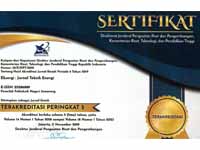Study of Hybrid Wind and Solar Energy Power Plants: An Analysis of the Battery Charging and Discharging System
DOI:
https://doi.org/10.32497/eksergi.v21i03.7098Keywords:
Hybrid Generator, Battery Charging, DischargingAbstract
Alternative energy can address the issue of PLN electricity supply, which is not available in all regions of Indonesia. The hybrid system of solar cells and wind turbines is a clean and environmentally friendly energy source because it does not produce carbon dioxide (CO₂) or other gases that play a role in global warming. The purpose of this final project is to analyze the length of time needed by a hybrid generator to charge and discharge the battery using load variations. This test was conducted in the Energy Conversion Laboratory using a unit of hybrid system equipment produced by KTENG (Korea Technology). The method employed involves charging the battery with energy generated from the hybrid system and discharging it using variations in lamp load. The results of this study indicate that the time needed to charge the battery is 21.28 hours in slightly cloudy weather with a total current of 4.7 amperes, and the battery discharge reaches 200 hours using a 10-watt load.
Hybrid Generator, Battery Charging, and Discharging
References
[1] Q. Hassan, S. Algburi, A. Z. Sameen, H. M. Salman, and M. Jaszczur, “A review of hybrid renewable energy systems: Solar and wind-powered solutions: Challenges, opportunities, and policy implications,” Results in Engineering, vol. 20, p. 101621, Dec. 2023, doi: 10.1016/j.rineng.2023.101621.
[2] Y. F. Nassar, H. J. El-Khozondar, and M. A. Fakher, “The role of hybrid renewable energy systems in covering power shortages in public electricity grid: An economic, environmental and technical optimization analysis,” J Energy Storage, vol. 108, p. 115224, Feb. 2025, doi: 10.1016/j.est.2024.115224.
[3] F. Perdiansyah, E. T. N. Fitriana, N. Aziema, P. P. Maharani, F. Khoerunnisa, and N. Winarno, “The Efficient Implementation of Hybrid Power Plants in Indonesia,” ASEAN Journal of Science and Engineering, vol. 1, no. 3, pp. 213–220, Aug. 2021, doi: 10.17509/ajse.v1i3.34226.
[4] A. Couto and A. Estanqueiro, “Wind power plants hybridised with solar power: A generation forecast perspective,” J Clean Prod, vol. 423, p. 138793, Oct. 2023, doi: 10.1016/j.jclepro.2023.138793.
[5] K. K. Jaiswal et al., “Renewable and sustainable clean energy development and impact on social, economic, and environmental health,” Energy Nexus, vol. 7, p. 100118, Sep. 2022, doi: 10.1016/j.nexus.2022.100118.
[6] C. N. Nwagu, C. O. Ujah, D. V. V. Kallon, and V. S. Aigbodion, “Integrating solar and wind energy into the electricity grid for improved power accessibility,” Unconventional Resources, vol. 5, p. 100129, Jan. 2025, doi: 10.1016/j.uncres.2024.100129.
[7] E. Ejuh Che, K. Roland Abeng, C. D. Iweh, G. J. Tsekouras, and A. Fopah-Lele, “The Impact of Integrating Variable Renewable Energy Sources into Grid-Connected Power Systems: Challenges, Mitigation Strategies, and Prospects,” Energies (Basel), vol. 18, no. 3, p. 689, Feb. 2025, doi: 10.3390/en18030689.
[8] A. A. Firoozi, A. A. Firoozi, and M. R. Maghami, “Harnessing photovoltaic innovation: Advancements, challenges, and strategic pathways for sustainable global development,” Energy Conversion and Management: X, vol. 27, p. 101058, Jul. 2025, doi: 10.1016/j.ecmx.2025.101058.
[9] S. Wang, E. Tonge, I. Sekanyo, E. Portmann, and S. M. Azzouz, “On the State-of-the-Art of Solar, Wind, and Other Green Energy Resources and Their Respective Storage Systems,” Eng, vol. 4, no. 1, pp. 857–883, Mar. 2023, doi: 10.3390/eng4010052.
[10] A. Ghosh, “Nexus between agriculture and photovoltaics (agrivoltaics, agriphotovoltaics) for sustainable development goal: A review,” Solar Energy, vol. 266, p. 112146, Dec. 2023, doi: 10.1016/j.solener.2023.112146.
[11] H. H. Zeddies, M. Parlasca, and M. Qaim, “Agrivoltaics increases public acceptance of solar energy production on agricultural land,” Land use policy, vol. 156, p. 107604, Sep. 2025, doi: 10.1016/j.landusepol.2025.107604.
[12] J. Wu, J. Xiao, J. Hou, and X. Lyu, “Development Potential Assessment for Wind and Photovoltaic Power Energy Resources in the Main Desert–Gobi–Wilderness Areas of China,” Energies (Basel), vol. 16, no. 12, p. 4559, Jun. 2023, doi: 10.3390/en16124559.
[13] A. Dascalu, S. Sharkh, A. Cruden, and P. Stevenson, “Performance of a hybrid battery energy storage system,” Energy Reports, vol. 8, pp. 1–7, Nov. 2022, doi: 10.1016/j.egyr.2022.05.040.
[14] S. Algburi et al., “Evaluating the Viability and Potential of Hybrid Solar-Wind Renewable Energy Systems in Relation to Geographical and Environmental Factors,” Results in Engineering, p. 103473, Nov. 2024, doi: 10.1016/j.rineng.2024.103473.
[15] M. A. Russo, D. Carvalho, N. Martins, and A. Monteiro, “Future perspectives for wind and solar electricity production under high-resolution climate change scenarios,” J Clean Prod, vol. 404, p. 136997, Jun. 2023, doi: 10.1016/j.jclepro.2023.136997.
[16] S. Piller, M. Perrin, and A. Jossen, “Methods for state-of-charge determination and their applications,” J Power Sources, vol. 96, no. 1, pp. 113–120, Jun. 2001, doi: 10.1016/S0378-7753(01)00560-2.
Downloads
Published
Issue
Section
License
Copyright (c) 2025 F Gatot Sumarno, Bah Evan, Vita Ayu Aspriyanti, Muhammad Alwi

This work is licensed under a Creative Commons Attribution 4.0 International License.
Authors who publish with this journal agree to the following terms:Authors retain copyright and grant the journal right of first publication with the work simultaneously licensed under a Creative Commons Attribution License that allows others to share the work with an acknowledgement of the work's authorship and initial publication in this journal.
Authors are able to enter into separate, additional contractual arrangements for the non-exclusive distribution of the journal's published version of the work (e.g., post it to an institutional repository or publish it in a book), with an acknowledgement of its initial publication in this journal.
Authors are permitted and encouraged to post their work online (e.g., in institutional repositories or on their website) prior to and during the submission process, as it can lead to productive exchanges, as well as earlier and greater citation of published work (See The Effect of Open Access).






